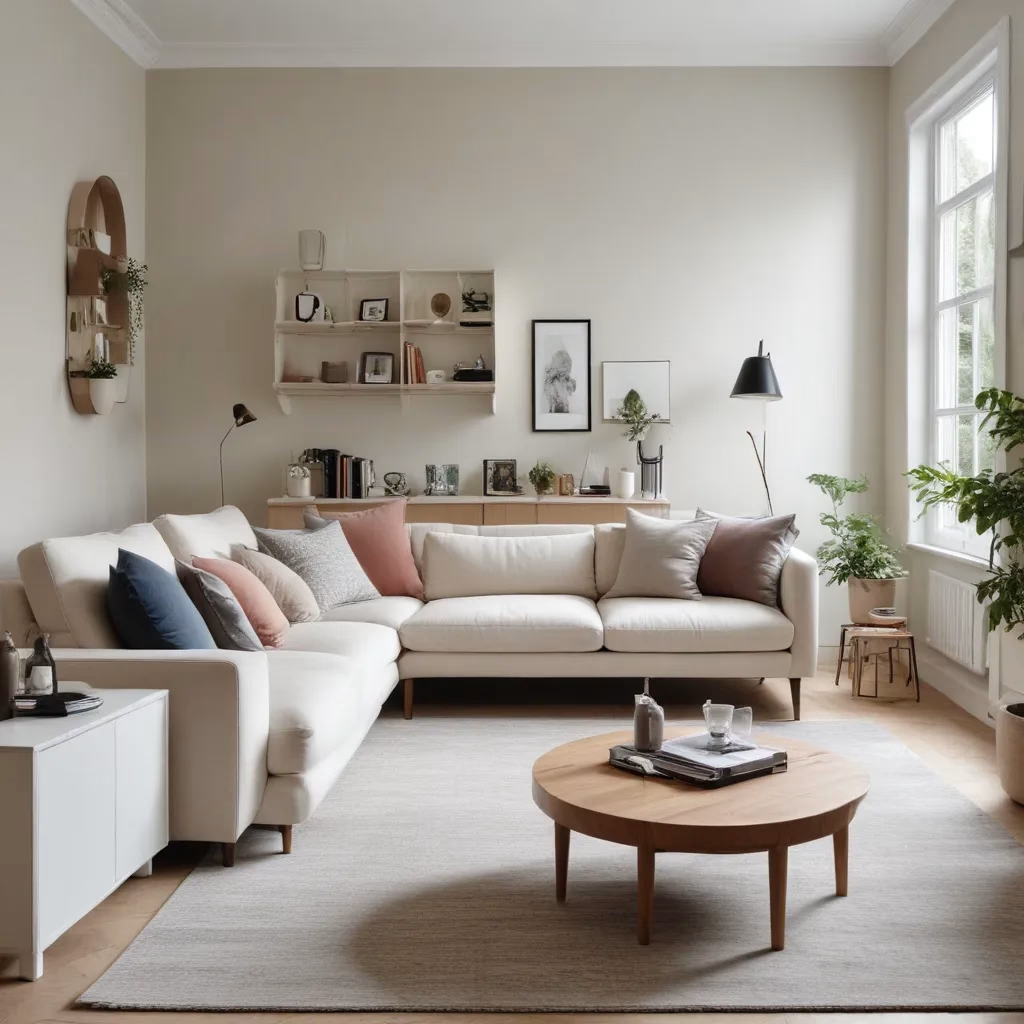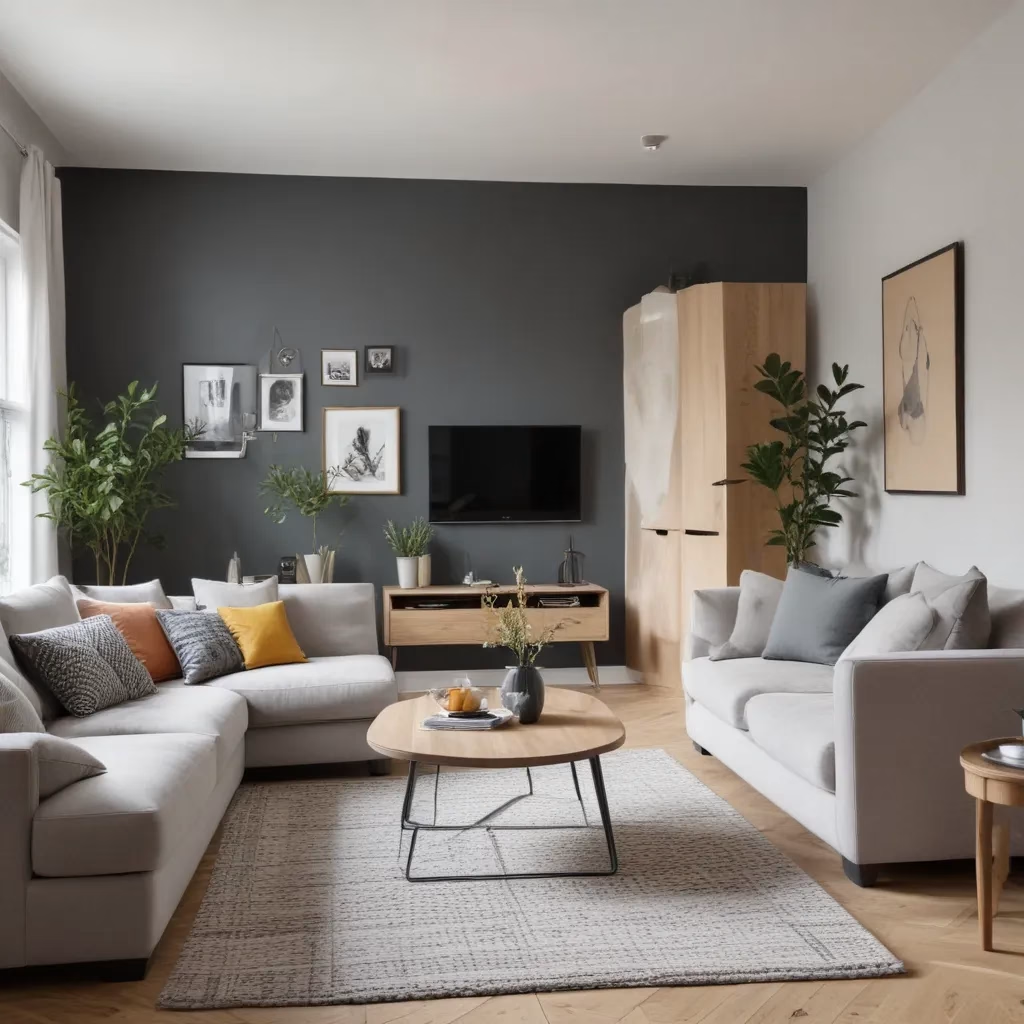
As an experienced furniture consultant and interior design writer, I know that creating a cozy, comfortable living room in a small space can be a real challenge. But with the right sofa selection, furniture arrangement, and thoughtful décor choices, you can transform even the tightest of living areas into a relaxing, stylish haven.
Now, this might seem counterintuitive…
In this comprehensive guide, I’ll share my top tips for maximising comfort and style in compact living rooms. From sofa fabrics and upholstery to multifunctional furniture and space-saving layout strategies, you’ll discover countless ways to make the most of your limited square footage. Let’s dive in!
Sofa Selection and Upholstery
The sofa is often the centrepiece of a living room, so choosing the right one is crucial – especially when dealing with a small space. The fabric, silhouette, and size of your sofa can make a big difference in how the room feels.
Fabric and Upholstery Considerations
When it comes to upholstery fabrics, opt for durable, easy-to-clean options that can withstand daily use. Microfiber, velvet, and performance fabrics like Crypton are all excellent choices that resist stains and wear. Avoid bulky, heavily textured upholstery, which can make a room feel cramped.
Look for sofas with clean, streamlined silhouettes that don’t overwhelm the space. Track arms, straight backs, and low profiles create a modern, minimalist look that’s perfect for small living rooms. Leather and tufted upholstery can also work well, but be mindful of the overall visual weight.
Sofa Styles for Small Spaces
In a compact living room, a loveseat or apartment-sized sofa is often the best option. These smaller-scale sofas come in a range of styles, from traditional to contemporary, and can free up valuable floor space. Sectional sofas with chaise lounges are another smart choice, as they provide ample seating without taking up too much room.
If you have the opportunity to custom-order a sofa, consider a sleeper sofa or sofa bed – the extra functionality can be a game-changer in a small space. Just be sure to measure carefully to double-check that the piece fits your room’s dimensions.
Measuring for the Perfect Fit
Before making any purchasing decisions, measure your living room carefully. Take note of the room’s width, depth, and ceiling height, as well as any architectural features or obstacles that could impact furniture placement. This will help you find a sofa that’s the right size and scale for the space.
When measuring, don’t forget to account for walkways and clearance around the sofa. You’ll want at least 18-24 inches of space on each side to allow for easy movement. And be sure to consider the sofa’s depth – a deeper seat (often 40 inches or more) can make a small room feel even more cramped.
Living Room Layout Strategies
Now that you’ve selected the perfect sofa, it’s time to think about how to arrange your living room furniture for maximum comfort and functionality. Here are some clever layout ideas to try:
Space-Saving Furniture Arrangements
One of the best ways to make a small living room feel more spacious is to pull furniture away from the walls. Instead, create a cozy conversation area by grouping your sofa and chairs around a central coffee table or ottoman. This layout not only makes the room feel more inviting, but it also helps to visually expand the space.
Another smart trick is to choose multi-functional furniture pieces that serve double duty. For example, an upholstered ottoman can act as both a footrest and a coffee table when topped with a tray. Nesting tables or side tables with storage are also excellent options for maximising limited square footage.
Lighting and Décor Placement
Proper lighting is key in a small living room, as it can help create the illusion of a larger, more open space. Floor lamps and table lamps with adjustable brightness allow you to control the ambiance, while pendant lights or sconces can draw the eye upward, making the ceiling feel higher.
When it comes to decor, hang mirrors strategically to reflect light and create a sense of depth. Vertical elements like bookcases, tall plants, or floor-to-ceiling curtains can also make a room feel more expansive. Stick to a neutral colour palette and clean-lined accessories to maintain a streamlined, uncluttered look.
Multifunctional Furniture Options
In a small living room, every piece of furniture needs to pull its weight. Look for versatile, multi-use pieces that can serve various purposes. A storage ottoman or coffee table with built-in shelves can provide concealed storage, while a window seat or built-in banquette can offer extra seating and display space.
Another smart solution is to invest in modular furniture, such as a sectional sofa with movable chaise or armless chairs that can be rearranged as needed. These flexible pieces allow you to customise the layout to suit your changing needs and entertaining style.
Sofa Care and Maintenance
Proper care and maintenance are essential for keeping your small-space sofa looking its best and lasting for years to come. Here are some tips to help you preserve the quality and comfort of your investment:
Cleaning and Stain Removal
Regularly vacuum or brush your sofa’s upholstery to remove dust and debris. For deeper cleaning, use a mild, fabric-safe detergent and a soft-bristle brush or sponge. Be sure to test any cleaning solution in an inconspicuous area first to double-check that it won’t damage the fabric.
If you do encounter a spill or stain, act quickly to blot the affected area with a clean, absorbent cloth. Avoid rubbing, as this can push the stain deeper into the fabric. Depending on the type of stain, you may be able to treat it with a dedicated upholstery cleaner or a DIY solution of mild soap and water.
Upholstery Repair and Restoration
Over time, even the most well-cared-for sofa can start to show signs of wear and tear. If you notice loose threads, rips, or worn cushions, don’t hesitate to have the piece professionally repaired. Many upholstery shops and furniture retailers offer restoration services that can breathe new life into your beloved sofa.
For minor issues, like flattened cushions or sagging seats, you may be able to address them yourself. Try fluffing the cushions regularly or rotating them to double-check that even wear. If the cushions have lost their support, consider replacing the foam inserts or adding a memory foam topper.
Prolonging the Life of Your Sofa
To extend the lifespan of your small-space sofa, be mindful of its placement and usage. Avoid direct sunlight, which can cause the fabric to fade, and rotate the cushions regularly to distribute wear evenly. If you have pets, consider using throw blankets or slipcovers to protect the upholstery.
When not in use, gently fluff the cushions and store any decorative pillows or throws to maintain the sofa’s shape. And don’t forget to vacuum under and behind the sofa periodically to remove any accumulated dust or debris.
Styling for Comfort and Aesthetics
Creating a cosy, inviting living room is about more than just the furniture – it’s also about the textiles, colours, and accessories you choose to enhance the space. Here are some tips for styling your small living room for maximum comfort and style:
Layering Textiles and Accessories
Throw pillows, blankets, and area rugs are essential for adding warmth and texture to a small living room. Mix and match different patterns, materials, and colours to create a layered, visually interesting look. Just be sure to keep the overall palette cohesive and avoid overwhelming the space with too many competing elements.
Incorporate soft, plush fabrics like velvet, chenille, or microsuede to make the room feel cocooning and inviting. Textural elements like woven baskets, macramé wall hangings, or shag rugs can also add depth and visual interest.
Colour and Pattern Coordination
When it comes to colour schemes for a small living room, stick to a neutral base with pops of accent hues. Whites, greys, and beiges create a clean, airy foundation, while blues, greens, or jewel-toned accents add a touch of personality.
For patterns, be selective and mix different scales to keep the room feeling balanced. Subtle, tone-on-tone prints work well for larger pieces like the sofa, while bolder, more graphic patterns can be introduced through throw pillows, area rugs, or wall art.
Creating a Cosy Ambiance
Lighting is crucial for setting the right mood in a small living room. Dimmable lamps and sconces allow you to control the ambiance, while candles and fairy lights can add a warm, inviting glow. Strategically placed mirrors can also help reflect light and create the illusion of a larger, brighter space.
Don’t forget about the finishing touches that make a room feel truly cosy and lived-in. Plush throws, decorative baskets, and potted plants can all contribute to a warm, welcoming atmosphere. Experiment with different textures, heights, and arrangements to find the perfect balance.
Furniture Buying Guides
When it comes to furnishing a small living room, quality and value for money are just as important as style and comfort. Here are some tips to help you identify well-made, long-lasting pieces that will stand the test of time:
Identifying Quality Construction
Look for sofas and chairs with sturdy, kiln-dried hardwood frames that won’t wobble or sag over time. Double-doweled joints, corner-blocked frames, and reinforced stress points are all signs of superior craftsmanship.
Pay attention to the upholstery as well. Tightly woven fabrics, high-density foam cushions, and well-secured tufting or piping indicate a higher-quality product that will withstand daily use.
Evaluating Comfort and Support
When testing out a sofa or chair, pay attention to how it supports your back and aligns your posture. Memory foam, pocket coils, or sinuous springs can all provide exceptional comfort and pressure relief.
Also, consider the seat depth and height – the perfect fit will allow your feet to rest flat on the floor with your thighs parallel to it. Adjustable, removable cushions can also help you customise the support to your liking.
Budgeting for Your Living Room
Outfitting a small living room can be a significant investment, but it’s important to strike a balance between quality and affordability. Set a realistic budget that factors in both the main furniture pieces and the decorative accents.
Look for sales, clearance items, or floor models that can help you save without sacrificing on style or durability. And don’t be afraid to mix high-end and budget-friendly pieces – the key is creating a cohesive, visually appealing space.
Ultimately, with the right sofa selection, furniture arrangement, and styling touches, you can transform even the most compact living room into a cosy, comfortable haven. By following the tips and strategies outlined in this guide, you’ll be well on your way to maximising every square inch of your small-space living room. Happy decorating!
Example: Living Room Makeover Series with Modular Sectionals



